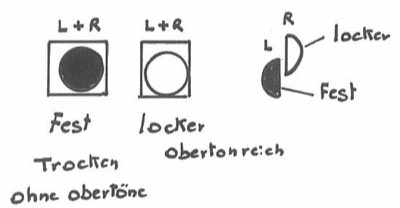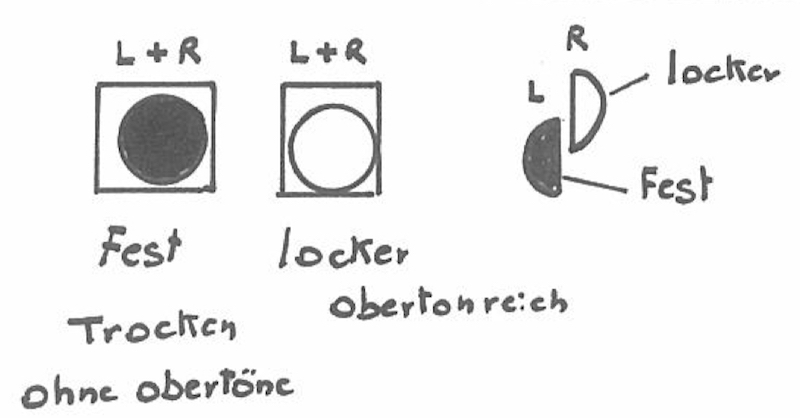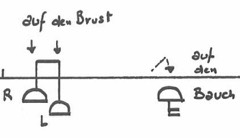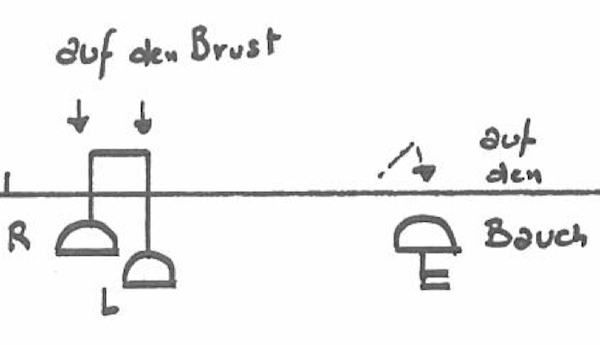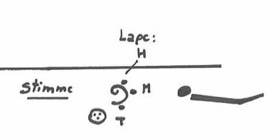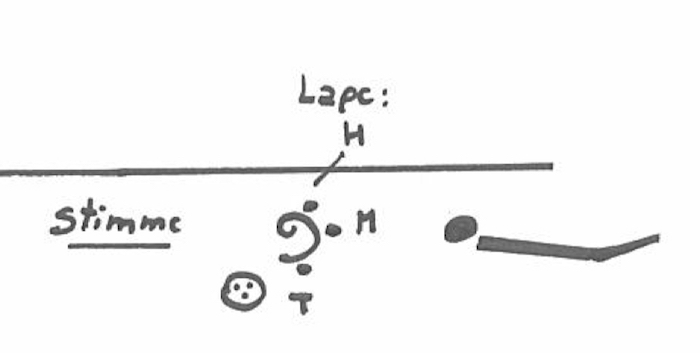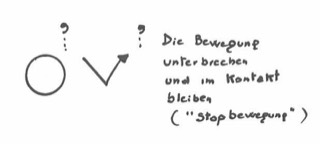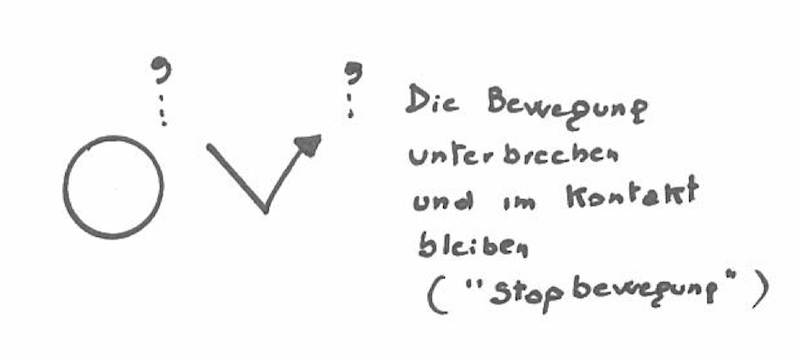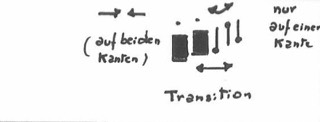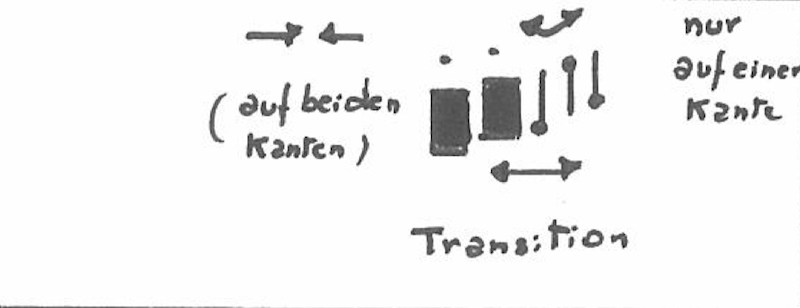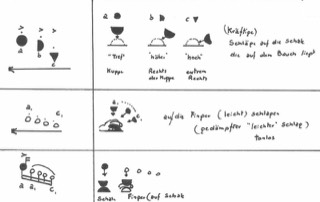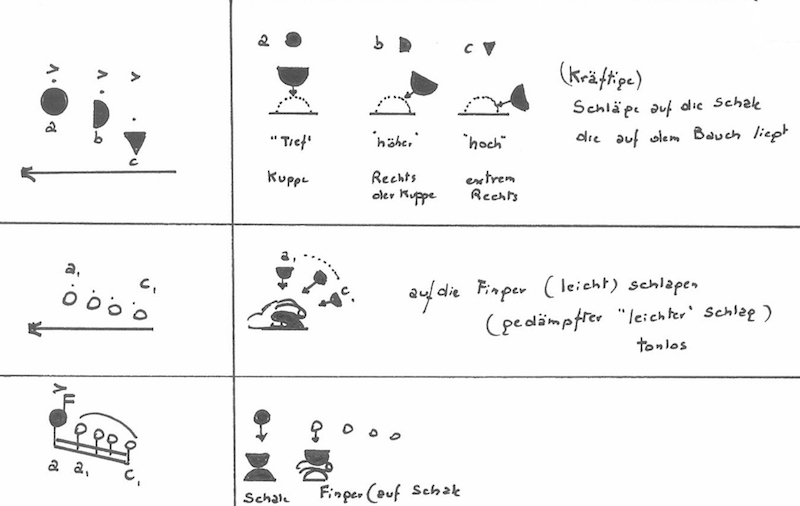Improving the practice and performance of contemporary music
Assimilation and adaptation of the different techniques and combinations
General technique
Billone asks for two ways of holding the sounding bowls: “fest” means the bowl is dampened by the hand that is holding it; “locker” means the bowl is half-dampened, involving the least skin contact possible in order to bring out the most overtones possible.
There are two general ways of playing, “Spielart 1” and Spielart 2” as displayed in the figure. The first involves mainly bowl-to-bowl playing; the second however involves one bowl that is held firmly to the abdomen to creat a kind of “resonance-box” while the other bowl hits the first.
The body of the player is also used as a percussion instrument: Billone asks for two playing techniques, one hitting the chest or “brust” (stems up) and the other hitting the abdomen or “bauch” (stems down).
The use of the voice involves three different “voice-positions:” low – middle – high. Be very careful about these positions because they give the piece an extra dimension and more depth. The voice in Billone’s music is always an extension of the other instruments, so it should never be too dramatic or present. In a way it serves as a “meta-instrument” that adds colour to the instruments that are used in that moment of the piece.
When Billone writes commas between certain movements in the piece, these commas serve as a sort of pause or break for the movement itself. They do not mean that the music itself or the flow of it is interrupted. The player should always keep the sounding bowls in contact with each other.
Spielart 1
- “Schlagen”: the bowls are hit together as you would hit two coconuts against each other. When the bowl is marked in white, you should hold this bowl loosely so there is some resonance; when it is marked black it should be hold firmly and should sound dry. On the figure you see the different contact points: the top position means the two bowls are to be played open with minimal contact (higher sound). The lower position means the bowls are to be played closed with maximal contact. The picture is quite clear. The last action that is described in this figure only occurs on page 4 of the piece and not on page 6 as stated in the performance notes. In this moment, the distance between the positions of the bowls should be different by half a centimetre. The resulting difference in sound will be minimal but still perceptible.
- “Trommeln”: in this technique the left bowl is held steady and the right bowl is played as if you would perform a one-handed roll on a marimba or the movement you make when playing a cabasa. The sounding result is a fast tremolo that can shift in pitch when the position of the bowls is altered. On page 2 of the piece, Billone asks for a tremolo that is measured in a certain rhythm. This can be a good exercise to learn how to control the trembling technique fully. Additionally, the transition between the two as displayed in the second figure is a good exercise to master this technique.
- “Reiben”: the first action is a “hin und her” or back and forth action, to be performed with quite a lot of power and decisiveness. Always stop the bowls and keep them in contact with each other after this action. For the second action, you need to scratch the right bowl back and forth while you move the same right bowl from an open to a more closed position. This should sound like a tremolo in a pitch-shifter. The third action with the typical “clack” sound is to be performed with quite a lot of power as well, moving the right bowl up and down. It sometimes helps to rotate the bowls slightly to obtain the clacking sound.
- “Circular movement”: this speaks for itself. The big circle means you make a full circle, the smaller circle only asks for a half or ¾-circle. These movements are always performed dry and dampened.
- “Slow movement”: here the action is very slow and with a lot of pressure. Just move the bowl from position a to b. The sound resembles slow grinding of teeth. It is to be performed in a quarter or half a circle.
- “Small circles”: small circular movements in an open bowl position. The sound is comparable to the sound in the “slow movement” technique, but the circles modulate the pitch here.
- “Speed circles”: the speed circles use the same positioning as in the “Impulse:” the small bow in the score means the contact between the bowls is minimal; the large bow means the contact is maximal. The technique sounds as it looks: rotational, as a slow-motion helicopter sound that varies in pitch.
- “Small circles on one side of the right bowl”: the right bowl is held loosely in this action to obtain maximal overtone ringing. The circles made with the right bowl modulate the overtone sound. Billone asks in a few places to open and close the right bowl to the left, which makes the modulation of the sound even bigger. The closed position has fewer overtones, and the open position contains more.
- “Hin und her streichen”: similar action to the one above, here the right bowl is to be rubbed back and forth. The right bowl is held loosely to obtain maximal overtones.
- Position 2 in Spielart 1: this position only appears on page 3 of the score, the bottom of the right bowl touches the edge of the left. There are three techniques as displayed in the figure: The first implies moving the right bowl in figure-eights over the edge of the left. A lot of overtones are obtained here. The second action is similar to the “hin und her streichen” action mentioned above. The right bowl is rubbed over the edge of the left. In the third action, the right bowl is to be struck inside the left bowl and immediately pulled out again, resulting in quite a loud clack sound.
- “Against each other”: in this technique, it is very important that when the bowls are ringing, the contact with the hands should be as small as possible. There are five different sub-techniques used: 1. Fully open; 2. Fully opened and dampened after a certain amount of time; 3. Fully open followed by the gradual dampening of one bowl until the other bowl stays ringing alone; 4. The dampened right bowl plays the left open bowl resulting in only one bowl sounding; 5. Played against each other fully dampened. The picture displays very clearly these five different playing types.
- “Body playing”: this figure shows the transition between Spielart 1 and 2. The first action shows the bowls to be struck on the chest. The second shows the left bowl being held to the abdomen while hitting this bowl with the right one.
Spielart 2
- “Schlagen”: this technique is performed either bowl-to-bowl or with the index finger between the two bowls. The bowl-to-bowl technique as well as the finger technique asks for different playing positions on the left bowl. Bowl-to bowl has three positions: a, b, and c. These positions are clearly displayed on the figure. In some parts of the piece, there are intermediate positions between these three. The main purpose of this technique is to have a clear variation in pitch. The finger technique asks for the same differentiation in positioning. This technique is very soft and the difference in pitch between the positions is not at all obvious to perceive . Therefore, it is better to slightly lift the left bowl from the abdomen in the beginning position (“a”) to raise the pitch. Moving to position “c” you can close the bowl to the abdomen again to lower the pitch. The third picture on the figure shows a combination of the two previous techniques as indicated at the top of page 9 of the score.
- “Streichen” and “Reiben”: The figure that displays this technique is again quite clear: “streichen” means rubbing the two bottoms of the bowls in small circles while holding the left bowl to the abdomen. “Reiben” means rubbing the same two bottoms back and forth quickly and forcefully while holding the right bowl loosely.
Independence of voice and hands
When practising and performing the piece, you will notice that the material for the voice in the score needs to be performed quite independently from what you are playing in the hands at some moments. This needs quite a lot of attention to obtain a natural-sounding result. If the basis for this is constructed in a natural way, the end result will sound flowing and easy, and this is exactly the desired outcome.
The voice part is very diverse and structurally important in Mani. Gonxha. It is very important to make as much differentiation as possible between the different sounds, vowels and consonants to obtain a voice part that moves together with the differentiation of the bowl sounds and techniques.
The parts where the voice performs a leading roll in the piece can be performed as someone praying to himself, reciting the ancient texts of different religions in an intimate way.
